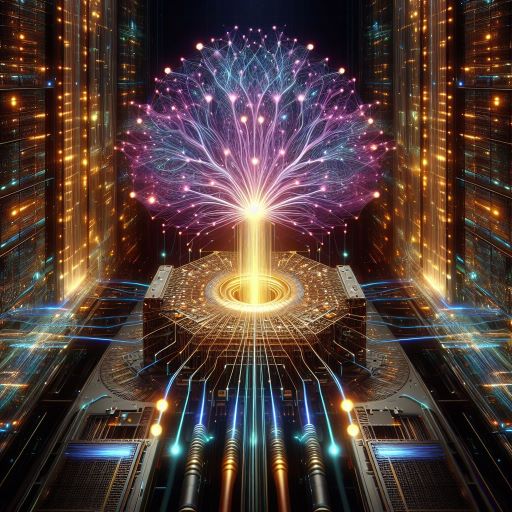The Ultimate Guide to AI: Exploring Machine Learning and Beyond
Artificial intelligence (AI) has captured our imagination for decades, from the futuristic visions of science fiction to the reality of self-driving cars and virtual assistants. Yet, amid the hype and excitement, the terminology often needs to be clarified. It’s enough to spin your head with machine learning, deep learning, and neural networks! But fear not, dear reader, for we’re here to shed some light on the subject.
In this digital age, where technology reigns supreme, understanding the difference between machine learning and artificial intelligence is more important than ever. Picture yourself navigating a sea of information, with AI as your compass and machine learning as your trusty map. Together, they guide us through the vast landscape of data and algorithms, offering insights and solutions to complex problems.
So, grab your virtual magnifying glass as we embark on a journey to demystify these terms and uncover the true essence of AI. Buckle up because it will be a wild ride through the fascinating artificial intelligence and machine learning world. Let’s dive in!
Understanding Machine Learning
Let’s delve deeper into the fascinating realm of machine learning. Imagine you have a robot buddy whose main job is to predict whether it will rain tomorrow. Initially, you give your robot some rules based on past weather patterns. However, your robot adjusts its predictions as new data rolls in. This ability to learn from data and improve its performance over time is the essence of machine learning.
According to “Demystifying AI and Machine Learning: A Beginner’s Guide” (Ask.com), “Machine learning is a subset of AI that focuses on enabling machines to learn from data without being explicitly programmed.” It’s like teaching a child to ride a bike by letting them practice and adjust their approach based on experience.
There are several types of machine learning, each with its strengths and applications. Supervised learning involves training a model on labeled data, where the correct answers are provided. It’s like studying for a test with an answer key – you learn to recognize patterns and make predictions based on previous examples.
On the other hand, unsupervised learning deals with unlabeled data, where the algorithm must find patterns and insights on its own. Exploring a new city without a map is like discovering hidden gems and connections through exploration and observation.
And then there’s reinforcement learning, which operates on a reward-based system. It’s like training a dog to perform tricks – you provide feedback (treats or scolds) based on the actions taken, guiding the system toward optimal behavior.
Machine learning algorithms come in all shapes and sizes, from decision trees and random forests to neural networks and deep learning models. Each has its own set of strengths and weaknesses, making them suitable for different tasks and domains.
As we continue to push the boundaries of what’s possible with machine learning, one thing is clear: the future is bright, and the possibilities are endless. So, whether you’re a data scientist building cutting-edge models or a curious bystander eager to learn more, there’s never been a better time to explore the fascinating world of machine learning. Let’s dive in and uncover the magic behind the algorithms!
Decoding Artificial Intelligence
Now, let’s focus on the broader concept of artificial intelligence (AI). While machine learning is a crucial component of AI, AI encompasses broader capabilities. Think of AI as the big umbrella under which machine learning resides, along with other disciplines like natural language processing (NLP) and computer vision.
AI aims to create machines that can simulate human-like intelligence, allowing them to perform tasks that typically require human cognition, such as understanding language, recognizing objects, and making decisions. Unlike machine learning, which focuses on learning from data, AI seeks to replicate human intelligence through algorithms and programming.
Within the realm of AI, there are various subfields and approaches. Symbolic AI, or “good old-fashioned AI,” relies on explicit programming and rules to solve problems. It’s like following a recipe to bake a cake – you have a set of instructions to follow, and if you do it right, you’ll get a delicious outcome.
On the other end of the spectrum, we have neural networks and deep learning, which are inspired by the structure and function of the human brain. These models excel at tasks like image recognition and natural language processing by learning from vast amounts of data. It’s like training a baby to recognize faces – the more faces they see, the better they get at it.
Since its inception, artificial intelligence has made rapid progress, with advancements in algorithms, computing power, and data availability driving rapid progress. From self-driving cars to virtual assistants, AI is already profoundly transforming industries and reshaping our world.
But it’s not all sunshine and rainbows. AI raises ethical and societal concerns, from job displacement to algorithmic bias. As we continue to push the boundaries of what’s possible with AI, it’s crucial to tread carefully and consider the implications of our creations.
The Relationship Between Machine Learning and AI
So, what’s the connection between machine learning and artificial intelligence (AI)? Simply put, machine learning is a tool or technique used to achieve AI. It’s like a brick in the foundation of a building—essential but not the entire structure. AI combines various tools and methodologies, including machine learning, to create intelligent systems capable of performing complex tasks.
Think of AI as the grand vision, the ultimate goal of creating machines that can think, reason, and act autonomously. Machine learning is one of the key ingredients that help us get closer to that vision. It’s like a piece of the puzzle that forms a comprehensive AI system when combined with other techniques like natural language processing, computer vision, and robotics.
Machine learning provides the learning capabilities that AI systems need to adapt and improve over time. Whether recognizing speech, understanding text, or making predictions, machine learning algorithms excel at finding patterns and making sense of vast amounts of data. As our understanding of machine learning grows, so does our ability to create more intelligent and capable AI systems.
But machine learning is just one piece of the AI puzzle. We must integrate machine learning with other components, such as knowledge representation, reasoning, and planning, to achieve artificial intelligence. It’s like assembling a team of specialists, each with unique skills and expertise.
In essence, machine learning is the engine that drives many AI applications. Still, AI encompasses a broader range of technologies and techniques. By combining the power of machine learning with other AI methodologies, we can unlock the full potential of intelligent systems and pave the way for a future where machines honestly think and act like humans.
Conclusion: Embracing the Evolution
In conclusion, while machine learning and artificial intelligence are often used interchangeably, they serve distinct technological purposes. Machine learning empowers machines to learn from data and improve their performance. At the same time, artificial intelligence aims to imbue machines with human-like intelligence across various domains.
Understanding these nuances becomes increasingly crucial as we witness the evolution of AI technologies. So, the next time you hear someone mention AI, you’ll know that it’s more than just a fancy buzzword—it’s a fascinating world of innovation and possibility.
Do you have thoughts to share? Drop a comment below, and remember to like and share this post to spread the knowledge! Until next time, happy learning!
Check out more great articles here!
*If you enjoy this article, please give us a like below, share it on social media, and leave a comment with your thoughts. It really helps the blog. 😊
References:
Demystifying AI and Machine Learning: A Beginner’s Guide – Ask.com. https://www.ask.com/news/demystifying-ai-machine-learning-beginner-s-guide






Leave a Reply